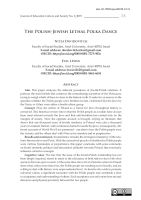The Polish-Jewish Lethal Polka Dance
Author(s)
Publication Name
Publication Date
Abstract
Aim. This paper analyses the inherent paradoxes of Jewish-Polish relations. It portrays the main beliefs that construct the contradicting narratives of the Holocaust, trying to weigh which of them is closer to the historic truth. It seeks for an answer to the question whether the Polish people were brothers-in-fate, victimized like the Jews by the Nazis, or if they were rather a hostile ethnic group.
Concept. First, the notion of Poland as a haven for Jews throughout history is conveyed. This historical review shows that the Polish people as a nation have always been most tolerant towards the Jews and that anti-Semitism has existed only on the margins of society. Next, the opposite account is brought, relying on literature that shows that one thousand years of Jewish residence in Poland were also a thousand years of constant friction, with continuous hatred towards the Jews. Consequently, different accounts of World War II are presented – one shows how the Polish people were the victims, and the others deal with Poles as by-standers and as perpetrators.
Results and conclusion. Inconsistency remains the strongest consistency of the relations between Jews and Poles. With the unresolved puzzle of whether the Polish people were victims, bystanders or perpetrators, this paper concludes with some comments on Israeli domestic political and educational attitudes towards Poland, that eventually influence collective concepts.
Cognitive value. The fact that the issue of the Israeli-Polish relationship has not been deeply inquired, seems to attest to the reluctance of both sides to deal with what seems to form an open wound. At the same time, the revival of Jewish culture in Poland shows that, today more than ever, the Polish people are reaching out to Israelis, and are willing to deal with history at an unprecedented level. As Israelis who wish to promote universal values, a significant encounter with the Polish people may constitute a door to acceptance and understanding of others. Such acceptance can only stem from mutual discourse and physical proximity between the two peoples.
Concept. First, the notion of Poland as a haven for Jews throughout history is conveyed. This historical review shows that the Polish people as a nation have always been most tolerant towards the Jews and that anti-Semitism has existed only on the margins of society. Next, the opposite account is brought, relying on literature that shows that one thousand years of Jewish residence in Poland were also a thousand years of constant friction, with continuous hatred towards the Jews. Consequently, different accounts of World War II are presented – one shows how the Polish people were the victims, and the others deal with Poles as by-standers and as perpetrators.
Results and conclusion. Inconsistency remains the strongest consistency of the relations between Jews and Poles. With the unresolved puzzle of whether the Polish people were victims, bystanders or perpetrators, this paper concludes with some comments on Israeli domestic political and educational attitudes towards Poland, that eventually influence collective concepts.
Cognitive value. The fact that the issue of the Israeli-Polish relationship has not been deeply inquired, seems to attest to the reluctance of both sides to deal with what seems to form an open wound. At the same time, the revival of Jewish culture in Poland shows that, today more than ever, the Polish people are reaching out to Israelis, and are willing to deal with history at an unprecedented level. As Israelis who wish to promote universal values, a significant encounter with the Polish people may constitute a door to acceptance and understanding of others. Such acceptance can only stem from mutual discourse and physical proximity between the two peoples.
Topics
Genre
Geographic Coverage
Copyright Info
This work is licensed under a Creative Commons Attribution 4.0 International License.
Original Language
Volume/Issue
10(2)
Page Number / Article Number
15-31
DOI
Link
Link to article, The Polish-Jewish Lethal Polka Dance
Bibliographic Information
The Polish-Jewish Lethal Polka Dance. 2019: 15-31. https://archive.jpr.org.uk/10.15503/jecs20192.15.31




